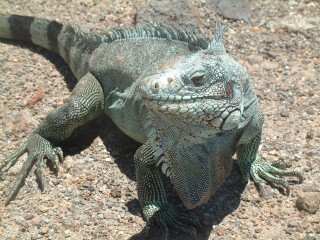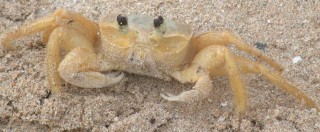
The Antillean Iguana, from Les Saintes
West Indies Fauna
For the avifauna of the islands: check out the West Indies birding page.
Tree frogs sing out their nighttime melodies on most of the islands, but we have yet to capture one and photograph it.
 The Antillean Iguana, from Les Saintes |
It wasn't long after sugarcane was introduced to the Windward Islands that some bright European decided that India's Mongoose would be a handy critter for killing the deadly Fer-de-Lance snake that lurked in the cane fields. Unfortunately, this efficient predator didn't limit itself to snakes and snake eggs, but has decreased the bird populations as well. Sleek, furry mongooses are often seen darting across roads, their long tails slithering behind them. (No, we haven't seen a fer-de-lance yet, and hope never to do so!)
The Antillean Iguana (above) sports a face only a mother could love, and seems to be perpetually saying "It's Monday morning!" Growing to over 3 feet (1m) long, they seem unafraid of people, but luckily not aggressive, either. We've seen the highest concentration of them on the ruins of Fort Napoleon in Les Saintes.
 |
We see lots of evidence of sand crabs, but it was fun to finally meet a few, toe to face, as it were, in the St. Vincent Grenadines. |
Top Level: Home | Destinations | Cruising Info | Underwater | Boat Guests | Ocelot | Sue | Jon | Amanda | Chris | Site Map | Make a Comment
|
If our information is useful, you can help by making a donation |
Copyright © 2000‑ Contact: Jon and Sue Hacking -- HackingFamily.com, svOcelot.com. All rights reserved.